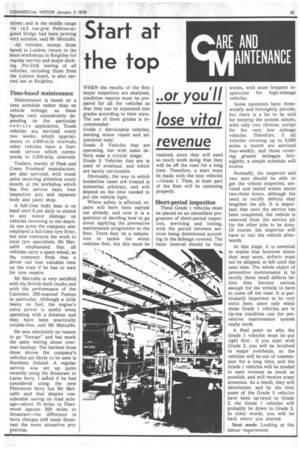Start at the top
Page 37

If you've noticed an error in this article please click here to report it so we can fix it.
..or you'll lose vital revenue
WHEN the results of the first major inspection are analysed, condition reports must be prepared for all the vehicles so that they can be separated into grades according to their state. The use of three grades is recommended : Grade 1: Serviceable vehicles, needing minor repair and adjustment only; Grade 2: Vehicles that are operating, but with some defects near a critical stage; Grade 3: Vehicles that are in need of overhaul, and which are barely serviceable.
Obviously, the way in which borderline cases are treated is somewhat arbitrary, and will depend on the time needed to put the vehicle right.
Where safety is affected, repairs will have been carried out already, and now it is a question of deciding how to go about applying the preventive maintenance programme to the fleet. There may be a temptation to tackle the worst vehicles first, but this must be resisted, since they will need so much work doing that they will be off the road for a long time. Therefore, a start must be made with the best vehicles —Grade 1. Then, at least part of the fleet will be operating properly.
Short-period inspection
These Grade 1 vehicles must be placed on an immediate programme of short-period inspection, servicing and testing, with the period between services being determined according to the mileage covered. The basic interval should be four weeks, with more frequent inspections for high-mileage vehicles.
Some operators have threeweekly and fortnightly periods, but there is a lot to be said for keeping the system simple, with only two choices, except for the very low mileage vehicles. Therefore, if all vehicles covering up to 5,000 miles a month are serviced four-weekly, and those covering greater mileages fortnightly, a simple schedule will evolve.
Normally, the inspector and two men should be able to get the vehicle inspected, serviced and tested within about two-three hours, although the need to rectify defects may lengthen the job. It is important that once the service has been completed, the vehicle is removed from the service pit for the 'other jobs to be done. Of course, the inspector will have to test the vehicle afterwards.
At this stage, it is essential to realise that however minor they may 'seem, defects must not be skipped, or left until the next time. The whole object of preventive maintenance is to rectify these' small defects before they become serious enough for the vehicle to have to come off the road. It is particularly important to be very strict here, since only when these Grade 1 vehicles are in tip-top condition can the preventive maintenance system really work.
A final point on why the Grade 1 vehicles must be put right first: if you start with Grade 3, you will be involved in major overhauls, so the vehicles will be out of commission for a long time, and the Grade 1 vehicles will be needed to earn revenue •as much as possible, and will receive scant attention. As a result, they will deteriorate, and by the time some of the Grade 3 vehicles have been up-rated to Grade 2, the Grade 1 vehicles will probably be down to Grade 2. In other 'words, you will be back where you started.
Next week: Looking at the labour revirement,




































































